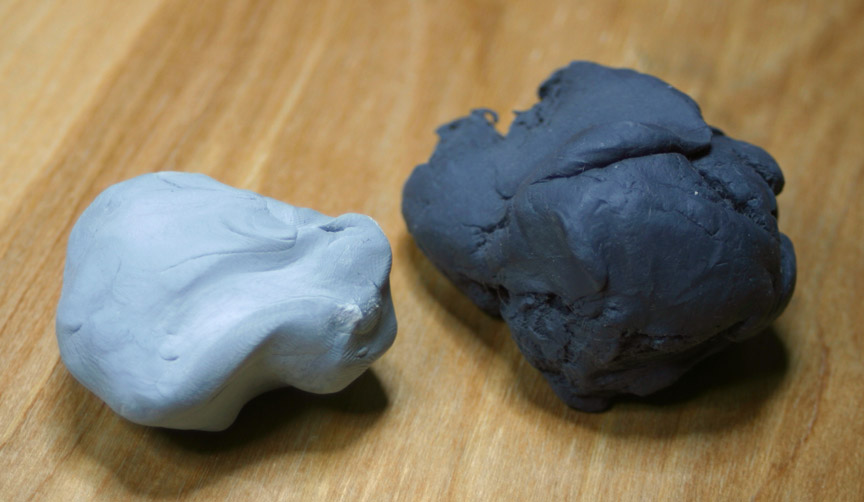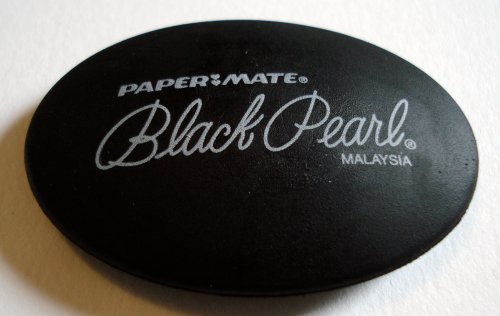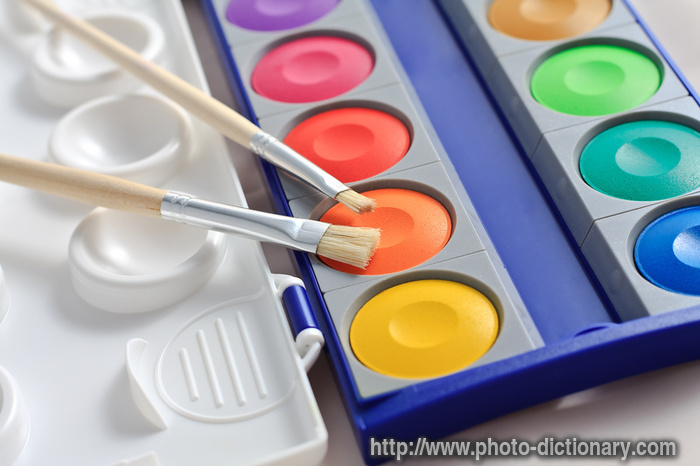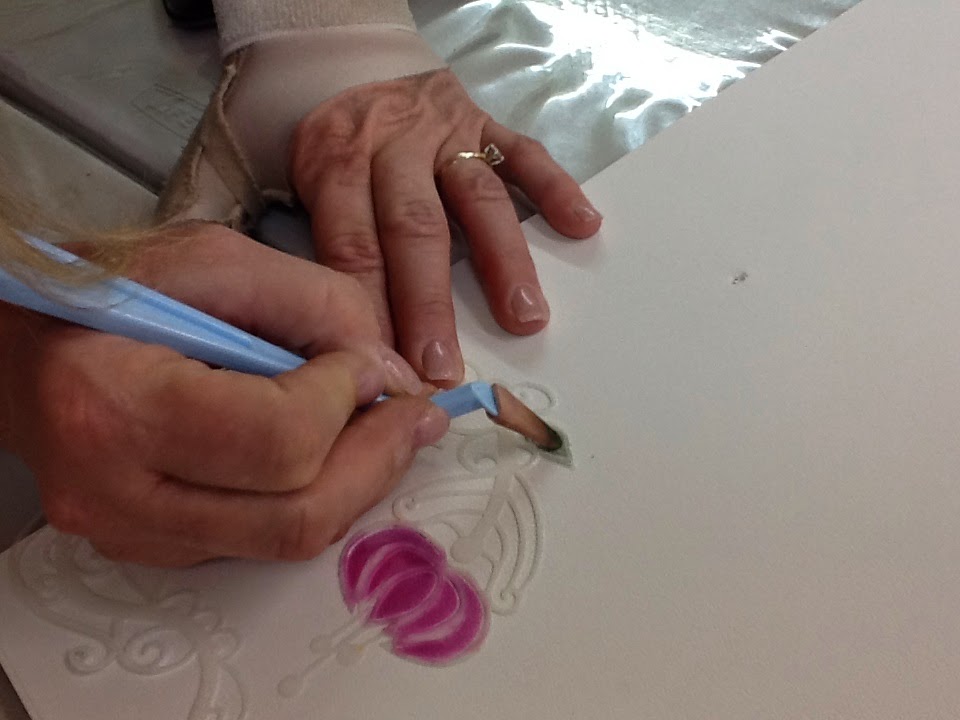Friday, June 27, 2014
Acrylic Painting Tip #5 Never Use Solvents
Never use solvents like turpentine or white spirits when washing your brushes. Acrylics don’t require anything more than water and soap. You can follow up with a nice brush conditioner/preserver like 'The Masters". Solvents such at Natural Turpenoid, are used when cleaning oil based paints out of your paintbrushes.
Thursday, June 26, 2014
Jewelry Making Tip #1 Enough Tools
Card Making Tip #5 Tri-Fold Cards
Wednesday, June 25, 2014
Oil Painting Tip #5 How to clean dried oil paint off your brushes
Cleaning Dried Oil Paint Off Your Brushes.
By Pamela Queen
Soak your dried dirty brushes in an Acetate Nail Polish Remover for 2 to 3 minutes, then follow up with Natural Turpenoid for the stubborn dried paint. Repeat as necessary.
By Pamela Queen
Soak your dried dirty brushes in an Acetate Nail Polish Remover for 2 to 3 minutes, then follow up with Natural Turpenoid for the stubborn dried paint. Repeat as necessary.
Finish up with a good brush soap & preserver.
Friday, June 20, 2014
Pastels Tip #4 How to Keep your Pastels Pristine
How to Keep your Pastels Pristine?
By Pamela Queen
 If you are like me, I have spent quite a bit of money on my wonderful Pastels, yet did not know how to keep them clean. My wonderful boss De informed me of her way of cleaning her Pastels. Clean them with flour! Yes, add just a bit of rice flour to a plastic container, and place your pastels in the flour, and gently shake/agitate the plastic container until you see that your little Pastel sticks are all clean. Works like a charm.
If you are like me, I have spent quite a bit of money on my wonderful Pastels, yet did not know how to keep them clean. My wonderful boss De informed me of her way of cleaning her Pastels. Clean them with flour! Yes, add just a bit of rice flour to a plastic container, and place your pastels in the flour, and gently shake/agitate the plastic container until you see that your little Pastel sticks are all clean. Works like a charm.
____________________________________________________________________
By Pamela Queen
 If you are like me, I have spent quite a bit of money on my wonderful Pastels, yet did not know how to keep them clean. My wonderful boss De informed me of her way of cleaning her Pastels. Clean them with flour! Yes, add just a bit of rice flour to a plastic container, and place your pastels in the flour, and gently shake/agitate the plastic container until you see that your little Pastel sticks are all clean. Works like a charm.
If you are like me, I have spent quite a bit of money on my wonderful Pastels, yet did not know how to keep them clean. My wonderful boss De informed me of her way of cleaning her Pastels. Clean them with flour! Yes, add just a bit of rice flour to a plastic container, and place your pastels in the flour, and gently shake/agitate the plastic container until you see that your little Pastel sticks are all clean. Works like a charm.____________________________________________________________________
 | |||
| https://www.scrappycraft.com/ |
Thursday, June 19, 2014
Card Making Tip #4 Decorate the Backside
Drawing & Sketching Tip #4 What Eraser to use?

What Eraser to use?
By Pamela Queen
Different paper types, different pencils require different erasers.
The History of the eraser.
 "Before rubber erasers, tablets of rubber or wax were used to erase lead
or charcoal marks from paper. Bits of rough stone such as sandstone or pumice
were used to remove small errors from parchment or papyrus documents
written in ink. Crustless bread was used as an eraser in the past; a Meiji-era
(1868-1912) Tokyo student said: "Bread erasers were used in place of
rubber erasers, and so they would give them to us with no restriction on
amount. So we thought nothing of taking these and eating a firm part to
at least slightly satisfy our hunger."[1]
"Before rubber erasers, tablets of rubber or wax were used to erase lead
or charcoal marks from paper. Bits of rough stone such as sandstone or pumice
were used to remove small errors from parchment or papyrus documents
written in ink. Crustless bread was used as an eraser in the past; a Meiji-era
(1868-1912) Tokyo student said: "Bread erasers were used in place of
rubber erasers, and so they would give them to us with no restriction on
amount. So we thought nothing of taking these and eating a firm part to
at least slightly satisfy our hunger."[1] http://en.wikipedia.org/wiki/Eraser
http://en.wikipedia.org/wiki/Eraser |
||
 |

Watercolor Tip #4 Using Niji Waterbrushes & Peerless Watercolor Papers for Travel and Transportability
Using Niji Waterbrushes & Peerless Watercolor Papers for Travel and Transportability
These are great for packing up in a backpack to take along hiking, or going to the beach.

Acrylic Painting Tip #4 Sealing in Iridescent Acrylic Paints
Sealing in Iridescent Acrylic Paints
Be sure to test out the sealer/varnish you use if you are using iridescent paints. I recently found out the hard way that the the spray on sealant/varnish I choose for my large acrylic piece muted and dulled the iridescent colors to the point of loosing all iridescent effect. Grrrr. That was quite a lesson to learn.
 Select your sealer and do a test spot on a different piece before you begin. See if it will hold up to what your requirements are for a sealer.
Select your sealer and do a test spot on a different piece before you begin. See if it will hold up to what your requirements are for a sealer.
Be sure to test out the sealer/varnish you use if you are using iridescent paints. I recently found out the hard way that the the spray on sealant/varnish I choose for my large acrylic piece muted and dulled the iridescent colors to the point of loosing all iridescent effect. Grrrr. That was quite a lesson to learn.
 Select your sealer and do a test spot on a different piece before you begin. See if it will hold up to what your requirements are for a sealer.
Select your sealer and do a test spot on a different piece before you begin. See if it will hold up to what your requirements are for a sealer.Oil Painting Tip #4 Paint Separation in Paint Tubes
Paint Separation in Paint Tubes
 Have you had this happen?
Have you had this happen? or as seen better in this image by
or as seen better in this image byPage by Marion Boddy-Evans -
Here's a quick and easy fix to this problem. Simply put the CLOSED tube of paint between both hands and roll the tube back and forth between the palms of your hands as shown in the image below.
This simple agitation is enough to remix the paint in your tubes.
Fine Art Tip #1 Learn how to price your art.
Learn How to Price Your Artwork!
by Pamela Queen
As an Artisan I have always felt a bit intimidated by the process of pricing my artwork, to be sold in a myriad of places. Be it online in my own e-commerce website, or online through a third party gallery. A big one, such as DeviantArt.com Or a small scale one such as an online local artist registry.
'How much do I price my art for hanging in a local gallery?'
Seemed to be a question that was haunting me. I need to sell my artwork and during this economic depression, I need to eat too. So, back the question of pricing my work for a gallery (The sad reality on the ridiculous prices galleries charge, example, here in Southern Oregon, I inquired at a new gallery downtown, only to find that they charge a $50 hang fee per piece and 40% commission upon sale. &#*&$#^). The math does not add up here.
But I digress. So how much do we struggling artists charge for our hard earned pieces? After all the gallery did not put it's blood sweat and tears into the piece..... sooo. I have struggled with this issue in so much as to loose sleep over it. (I know, a bit to extreme, I needed to find some balance and control.)
Upon doing a bit of research I have found a couple of really good websites that helped me to figure out what to charge per piece, per square inch and in what environment. Yippie!!
Huge Credit to them for the original research.
18 Dec 2009 by Lori Woodward
http://mariabrophy.com/
How to price your original artworks
__________________________________________________________________
www.scrappycraft.com
shop.scrappycraft.com
How to Price Your Original Artworks
How to Price Your Original Artworks
Wednesday, June 11, 2014
Card Making Tip #3 Don't Forget the Envelope.
 When Card making we usually get all excited in designing and creating the card we forget the envelope. The envelope is an excellent place for accenting with additional embellishments, & Distressing.
When Card making we usually get all excited in designing and creating the card we forget the envelope. The envelope is an excellent place for accenting with additional embellishments, & Distressing.
Pastels Tip #3 Dusting with Pastels
Dusting with Pastels
Tip 1: It is much easier to do this with the painting held horizontally - the pastel dust will fall exactly where you want it to, and not contaminate the rest of the picture.
Tip 2: Make sure the palette knife is really clean before trying this, and then even if you move the knife around a little bit it won't blend the colors together.
Scrapbooking Tip #3 Matting & Distressing Edges
Watercolor Painting Tip #3 Watercolors Dry Lighter
 Watercolors Dry Lighter
Watercolors Dry Lighter
With watercolor paint, a color will always look more intense (stronger and darker) when it is wet. A color will always be lighter and paler when dry.
It's something you get a feel for through practice and experience. If your paintings look insipid, make the colors more intense by using more paint and less water, or painting another layer of a color over the first.
It's something you get a feel for through practice and experience. If your paintings look insipid, make the colors more intense by using more paint and less water, or painting another layer of a color over the first.
Drawing & Sketching Tip #3 Use a Variety of Line
 Use a Variety of Line:
Use a Variety of Line:When drawing lines, either in a linear drawing or within a texture in a tonal drawing, note that you can vary the weight of the line by lifting the pencil or pressing harder. This might seem obvious, but it is important, and most people don't exploit lineweight enough. Note the example above, which shows how lifting the pencil towards the end of the stroke can be used to give a grassy or fluffy effect. It can be useful to reduce the weight as the pencil is applied at the start of the stroke, rather than dropping it straight into full pressure.
Acrylic Painting Tip #3 Blot your Brushes
 Blot your Brushes
Blot your BrushesKeep a piece of paper towel or cloth next to your water jar and get into the habit of wiping your brushes on it every time you rise them. This prevents water drops running down the ferrule and onto your painting, making blotches.
Wednesday, June 4, 2014
Drawing & Sketching Tip #2 Beginners Mistakes
Beginners Mistakes
When you are teaching yourself to draw using books and the internet, it can be difficult to know how to improve.
Without a teacher to help, we tend to keep making the same mistakes for
longer than a student in a classroom. The key to overcoming this
obstacle is to learn to look at your work with a fresh, critical eye. We
should feel rightly proud of the progress we make each time we create a
new drawing - don't let small flaws spoil your enjoyment! We need
mistakes because they help us to learn. Here is a list of the most
common mistakes that beginners make. Some of them are small, some are
big, and all can be fixed.
For best results in assessing your work, choose a few pieces that you completed some time ago - you can more easily be critical of a work that you haven't only just finished. Look for each of the mistakes listed, and choose one or two things to concentrate on next time you draw. Don't try to fix everything at once, and remember that it's more important to enjoy the drawing process!
1. Using A Hard Grade of Pencil
If you have no very dark shadows and the whole picture is rather pale, check your pencil. Are you using a Number2 (HB) pencil? These are too hard to draw with (though they are handy for light shading). Get a B, 2B and 4B for darker values.
Oil Painting Tip #2 Leave a Border
Leave a Border
Leave a white border around the edge of your painting. It not only gives you somewhere to 'test' your colors, but it means that when the painting is framed you won't loose any of it under the mounting board.
Watercolor Painting Tip #2 Watercolor Brushes Sable Stands Out!
Watercolor Brushes
Sable brushes are considered the ultimate in watercolor brushes because of the fine point the hairs reach, their ability to spring back into shape, and the amount of paint they hold. Less expensive options are brushes with a mixture of sable and synthetic hairs or 100% synthetic brushes. Unlike choosing paint, start with the cheaper brushes and upgrade as you become more proficient.Acrylic Painting Tip #2 Keeping Acylic Paints Wet & Workable
Tip 1: Keeping Acrylic Paints Workable
Because acrylics dry so fast, squeeze only a little paint out of a tube at a time. If you're using a 'normal' plastic palette invest in a spray bottle so you can spray a fine mist over the paint regularly to keep it moist, and thus usable. 'Stay-wet' palettes – where the paint sits on a sheet of wax paper place on top of a damp piece of watercolor paper – eliminate the need to do this, but generally don't have a hole for your thumb so are more awkward to hold in your hand.
Subscribe to:
Posts (Atom)






.JPG)
.JPG)
.JPG)
.JPG)









.JPG)




.JPG)
.JPG)

.JPG)



